The Agonising Ecstasy of our Quintessentially Human Sins
..in the musky, golden light of childhood, my sins remained as wisps of clouds that passed by me, sins I know I will not be judged for, sins that I know God lets pass by as clouds and nothing more..
I have always lived with a solid notion of good and bad, or more accurately, of sin and virtue, in the back of my mind. Only when I was 16 did I really have what I would call to be a relationship with my sins and with my virtues. Before that, in the musky, golden light of childhood, my sins remained as wisps of clouds that passed by me, sins I know I will not be judged for, sins that I know God lets pass by simply as clouds and nothing more substantial. ‘You shouldn’t do that’ was what my mum would say, and I wouldn’t do it. In some ways I was more virtuous as a child than I am now, and I’m not sure if that is a fact I should embrace with each year that I become more flawed and more virtuous.
To my mother, my childhood sins were something that we could talk about, that I could be told off for, and that was that. To my (birth) father, my sins were something that would not be discussed, that should be hidden, that only excused the delicate displays of violence he wished to inflict on me. Hearing my parents argue in the middle of the night was like hearing the angels on my shoulders fight for what I was; virtuous, or sinful? I was only six and my childhood was coloured with the feeling that I was not doing enough to be virtuous or as good as I should be, while my mother stood in the corner and watched and tried to make me see that of course I was good. But it was my father’s hand and voice that overpowered her tenderness. (Disclaimer: I haven’t seen my birth father since I was a child and I am completely happy with my religion, nor was I forced to be religious. I use this analogy simply because it defined my childhood and the way I saw my mistakes as a child).
I was in high school when I learnt that Christians believed it was Eve who had eaten from the tree first, then tempted Adam to do so. Even then I knew that that wasn’t fair. For her to take the blame, to be resented. If Eve had not listened to the snake, perhaps we women would not bleed. If Eve had not listened to the snake, perhaps pregnancy would hurt less, perhaps 12-year-old girls wouldn’t be crying in the bathroom, perhaps, perhaps, perhaps. It has been loaded into us like bullets that if Eve had not committed such a violent act of disobedience and disloyalty we would not have to suffer like we do. That girls would not have to suffer, that the whole of mankind would be eternally happy in paradise with no end to their pleasure. It has been loaded into us that it is a woman’s fault that we are here. But in reality it was not the manipulation of Adam that caused him to take the fruit from Eve, rather it was his love for her that meant he trusted her. It was him thinking - if she has done it, I will share in her pain, if she is to fall from heaven, I will fall with her; to share vicariously in experiences simply because the one you are sharing them with is one you do not want to be separated from. The fact that they share a rib only illustrates this. Adam was human, even if he was born in paradise - either he ate the fruit because a part of him (the sinful, human, flawed part) longed to have what was forbidden simply because it was forbidden, or he ate it due to love. The crux of the matter is, that either way, he was human, and bound to commit that act. One cannot blame Eve, they cannot blame Adam, and they cannot really blame the snake. The snake’s greatest flaw is that it is itself - the snake needed to torment and tempt, it is its nature. He cannot escape his character nor can he escape what he was destined to do. Like an ouroboros, it is a vicious cycle, and each pawn plays its worthy part.
Regardless, the story in my religion is similar yet differs hugely in some aspects. Islam exegesis does not state whether it was Adam or Hawa who ate the fruit first, but that both did, and were sent to live a life on earth. This was less the decisive moment and more what happened after. Adam begs God for forgiveness from the moment his feet hit soiled ground. Adam and Hawa being sent to Earth was less because of their disobedience and God’s wrath, but as part of God’s hikma (mercy) - God always has a plan, and he is the best of planners (Quran 8:30). Just as the Devil was bound to tempt them, Adam and Hawa were bound to be sent to Earth, and so begin a race of humans that would learn the full extent of God’s power, will, knowledge, and mercy. If we were all living in Heaven without a care in the world, existing day to day for eternity in pleasure and peace, we would not fully appreciate God’s character, nor would we need to. We would be satisfied. It is through the pain and hardship that we can be taught to appreciate, and it is through God’s mercy that we are allowed the chance to simply ask for pardoning, and so be pardoned.
It is for this very reason that the notion of original sin is not apparent in Islam, just as it is a continual thread in Christianity. To believe that humans are born with original sin is to accept that we are born flawed, and to be flawed as a human is inevitable. Nothing we do can prevent us from being born, tainted.
Pisanello’s Madonna and Child with Two Saints, delicately cradled in golden light like that of the sun or divine presence, illustrates a story where Saint Anthony Abbot rings his bell and looks sternly at the knight next to him. Saint George, stylish and elegant, in contemporary French fashion, has an emblem around his legs - a dragon hissing at Anthony’s boar. I bring this painting up not to highlight how perfect Jesus looked as a baby - entirely perfect and pure, not flawed nor sinful nor human, really - but to focus attention on Pisanello’s signature. Swirling and whimsical, one art historian remarked that the signature looked like it was comprised of small snakes. Perhaps, then, even as mankind tries to be good, we cannot escape our flawed humanity, nor the original sin that taints us.
It is intriguing to me how, though we admonish sin and a sinful lifestyle, it is continually running throughout history and its art and literature. To analyse humanity’s past is to analyse its sins, and to reflect on its art is to find a deadly sin poking its head through every subject matter. Even the Ancient Greeks, hedonists as they were, were conscious of their sin. Though they satisfied carnal lusts and appetites, drank till dawn and slept with married women - it is only the case that their ideas of sin are different from our monotheistic approach. Pride was deadly, just as it is a major sin now. Case in point: Sisyphus. The story of Sisyphus, though known more as a fairytale for the Ancient Greeks, is a blatant example of how deadly pride can be. By cheating Death in order to live longer, Sisyphus’ punishment is to be condemned to pushing a boulder up a hill, only to never reach the crevice, to fall back down eternally and have to start over. Rinse, repeat. Sisyphus’ afterlife is a turbulent display of achievements and downfalls, of getting somewhere, only to lose the progress. And yet this can be some sort of metaphor for how tiring it is to be a flawed human who cannot stray from their sins, whose body wants desperately to stray. Who asks for forgiveness, only to fall back into sin soon after. Our desires and our flaws are much too strong even for our resilience and firm dedication. We can learn much about how Ancient Greeks viewed sin (even if they didn’t have a name for it) through the cerebral punishments that subjects receive.
The ever-present theme that seems to be underlying in every piece of art is that of transgression. It is vast, versatile, and fluid, inherent in both life and art, throughout history. Sin suggests a transgression against the divine, it is personal, it is constant. Artists embrace sin as one of art’s most enduring subjects, portraying it as deeply ambiguous, problematic, and tragic. And art, through beauty, glorifies sin and justifies transgressions in poetics. It highlights indulgence, punishments and the actual act, using sin and beauty or pleasure as vice and virtue. There is something gorgeous, tragic, and visceral about the way it is depicted in art, whether that be for warnings or excusal.
I was not much younger than I am now when I first encountered the story of Mary Magdalene, as well as the countless depictions of her throughout time. Mary, ironically sharing a name with Jesus’ own mother, a former prostitute turned reverent and close companion of Jesus Christ. She is depicted penitent, remorse in those deep, dark eyes, hands clutched in grief and desperation. What a wonder it is that a woman buried in a lifestyle so far from what Christianity taught managed to leave behind what was familiar to her and what provided for her, in order to stay on the right path. What a wonder it is that she did not dwell on what others would say and cared only for what God would say. It is a wonder that she saw beyond her own flaws in order to see that her own soul was in fact worth saving, no matter how much sin she had committed. I love most that each depiction of her is different, that each artist imagined her penitence to show itself in different ways and yet each envisioned her to look incredibly similar. Georges de la Tour’s Magdalene (With a Smoking Flame, c.1640), for instance - reflective, sombre. Deep in her thoughts, hair cascading over her shoulders, exposing a pale collarbone. Her face is hardly shown - it is her gentle air as she sits, hand mindlessly pawing a skull, that does all of the work for us. We do not even need to see her face in order to glean who she is, what she is doing, how she is feeling. The light of the candle, the sole candle, the only source of light in the room, grants her a sort of white noise to stare into in order to peruse her mind, to feel whatever remorse she does. The cold skull, mouth and eyes, gaping and hollow, remind her of death. - subsequently, of the afterlife, and of fate. In a way, this painting is easy to sit with - we can sit with her, contemplate with her, bask in the close feeling of the dark room and be alone with our thoughts.
Caravaggio’s Mary Magdalen in Ecstasy, however, is entirely different. Suddenly, the subject has more noise, more action, more movement. Head tipped back, lips parted, fabric draping and barely covering her bosom - Caravaggio painted her exactly how one would expect Caravaggio to paint a former prostitute in repentance. This painting borders on erotic love while also making testament to divine ecstasy and the desperation that remorse can grant one. Eyes squinted shut, skin pale in comparison to the dark background, the painting is all textures and an enveloping madness. Conversely, in Tintoretto’s version, Mary is more spiritual, while still retaining aspects of her debauchery and sultry demeanour. Bare shoulders, cascading hair, a delicately-sculpted side profile, Mary looks upwards, to the breaking sky, hands clasped in reverence. She is surrounded by hay and all aspects of what makes viewers reminded of the transience of life. Her doe eyes gleam. Perhaps she is talking directly to God, perhaps she is striking a deal with him, asking him to forgive her despite it all.
The painting by Ciseri is my favourite depiction of Mary Magdalene. It is entirely different to the others, in fact, one is hardly able to tell that it is she at all. Her dress is draping, lush fabrics that cascade around her just like her waved hair, hiding her face, showing only a bare, golden shoulder and feet that touch the earth. She is encapsulated in grief and remorse. Seeing her for the first time, I had no idea that this was she, that she was crying for her sins, but in a way, that back story isn’t crucial for understanding. The painting captures the feeling that even if you are to cry to God for forgiveness, and he forgives you, it is harder still to forgive yourself. And yet, the painting is warm, gentle, the colours muted. Mary Magdalene is known for her sin, and despite how often she asks for forgiveness, that defining aspect will not change. Yet it is the story of her sin that makes her story more worthwhile.
It is a reminder that sometimes humans are harsher than any sort of divine power. Even if we may not judge ourselves for our sins, and God may not judge us, it is undeniable that we will be judged by others, and that is not a fact that I readily accept. When Adam’s story is told, we dwell on the transgression, and choose to ignore the fact that he was overcome by remorse and subsequently, immediately, asked for forgiveness. It is strange, that we are all full of guilt, grief, and flaws, yet refuse to see beyond the guilt and flaws of others. Where you would expect empathy, you are greeted with discernment.
The Woman Taken in Adultery (Rembrandt, 1644) illustrates this discernment. Like I said earlier, it is surprising that though we are ashamed of our sins we seem to wrap ourselves up in them through the media that we, and that our past civilisations, consumed. Why do we cling to such a thing as our own flaws? What appeal do we see in the forbidden, in the deadly mistakes, in the guilt? Rembrandt chooses a poignant moment to depict in this piece. Looking at it for the first time I was struck by its almost dusty and wan-coloured composition. It is full, yes, full of figures that leer and loom in the background - everyone is a judge - but all figures seem to be on death’s door. The woman, spotlighted in a ghostly white dress, definitely does, hardly able to stand, eyes cast downwards, cheeks sunken and pale, huge rings around her eyes. But her audience - consisting of only men - don’t look any different; dressed in tan robes, their faces hardly have any definition, granting the whole painting an air of exhaustion. Even Jesus, with his characteristic long hair and beard, does not stand out much. While the woman weeps on the steps, fearful of whatever judgement awaits her for her sins, the others also wait patiently - but it is obvious how they are inclined to judge her. They mean not only to punish the woman for her adultery but to trick Christ into transgressing Jewish law. Here is when Christ denounces - “Let he who is without sin cast the first stone.” It is a fateful moment, one cannot imagine the relief the woman was granted when released, but I draw your attention to this painting because I wholeheartedly believe that humans can fail to see the dirt in our own eyes, while judging the speck in another’s (Matthew 7). We cling to such a thing as our sins and yet are the first to judge. Even if we were to take religion out of it, to abandon the case entirely, I have no doubt that we would judge other’s flaws for simply being flaws, once they are brought to light.
Regardless, I write this essay simply because I wonder what it is about the art of transgression that has caused it to become one of the most dealt with themes of all time. I also do not shy away from the reality of my own sins, my own transgressions, while accepting them for what they are. Does this mean that art isn’t just beauty?


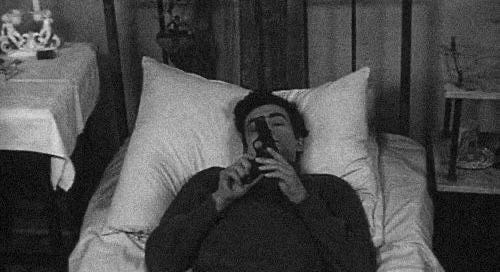



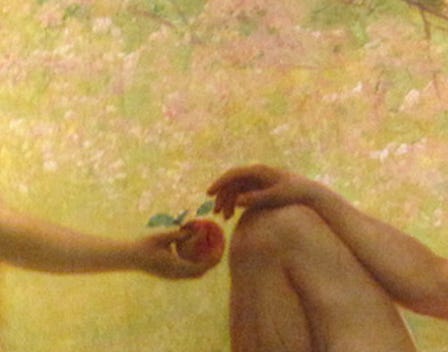

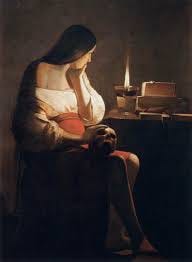
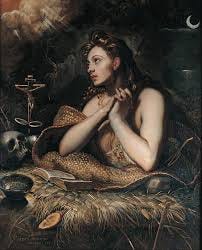

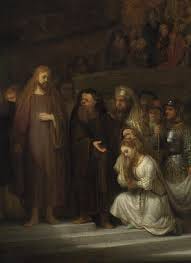
loved your piece. I often think of the serpent as the instigator of sin, in the context of Adam and Eve. Of course, Eve is a charged entity (or identity if you will), but how is that--Sin that is--the beginning of all human life as we know it? For if a world exists it does so in terms of the expulsion of Eden, and so on. I often wonder if the idea of sin is nothing but the the knot (or crux) of salvation.
PS. I loved the Magdalenas, btw. They're really something to meditate on--and you posted great paintings.
This was so beautifully written!! I love that your muslims aswell and dwelling into this topic, as a muslim writer, i find that i tend to disassociate from my religion when writing topics such as the philosophy of sin or any topic in general and see it from a broad aspect obviously leaning to Christian povs that makes me wonder if Im writing as me. I truly believe this is bcs the books I consume. Being the topics that interest me specifically that talk of sin are all from Christianity diction and not from muslim or even ex-muslim povs. This was the first work I read by a muslim that talks of the topics that deranges my sanity, and consumes my thoughts, and truly feels so much more thoughtful reading it from someone sharing the same religion. I hope you continue writing as such, as it does feel like an understanding i've never felt till I read your work!!